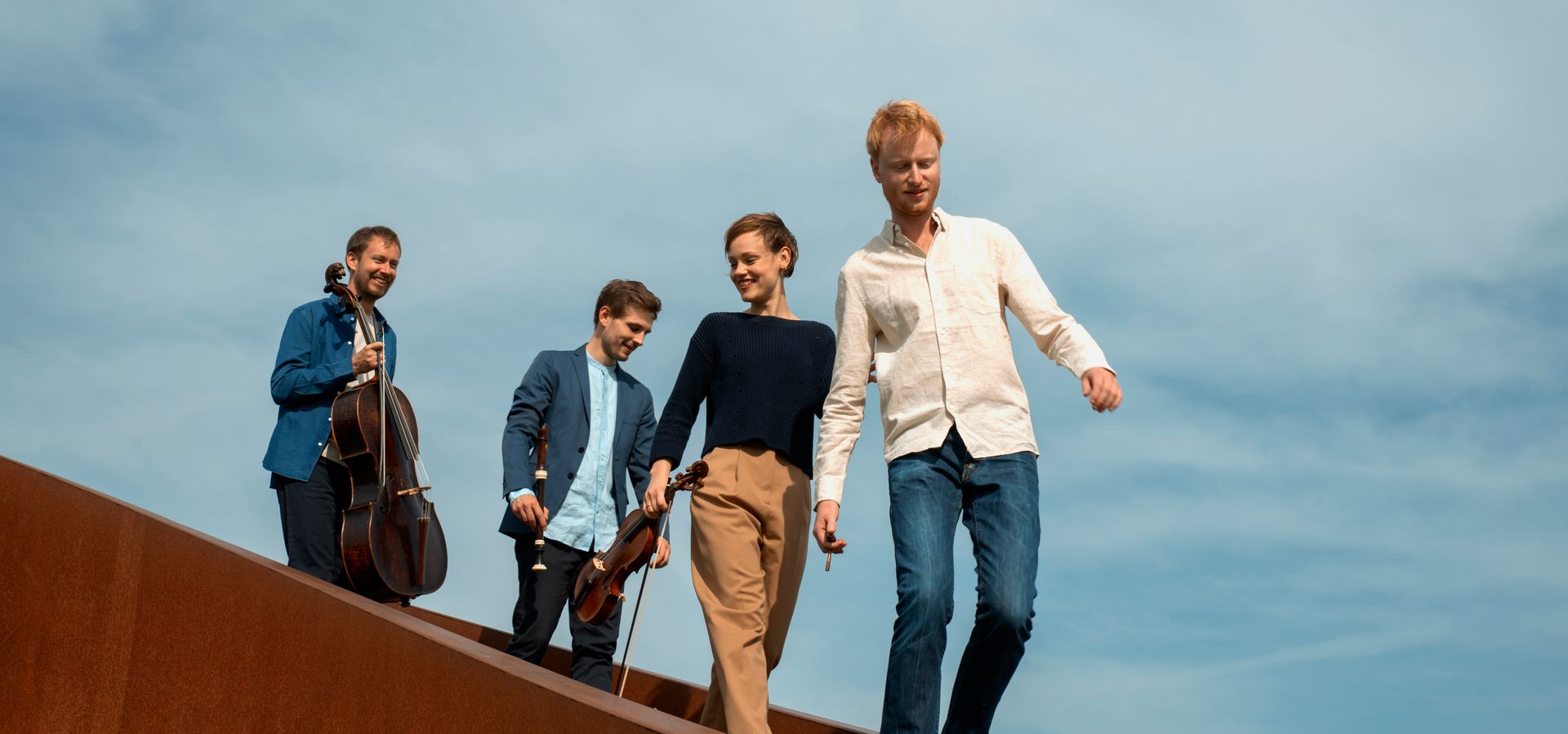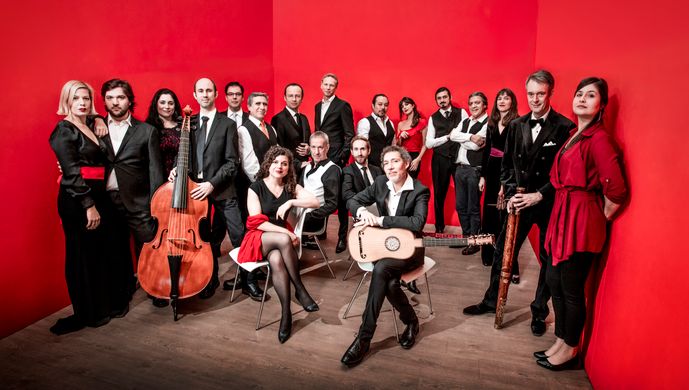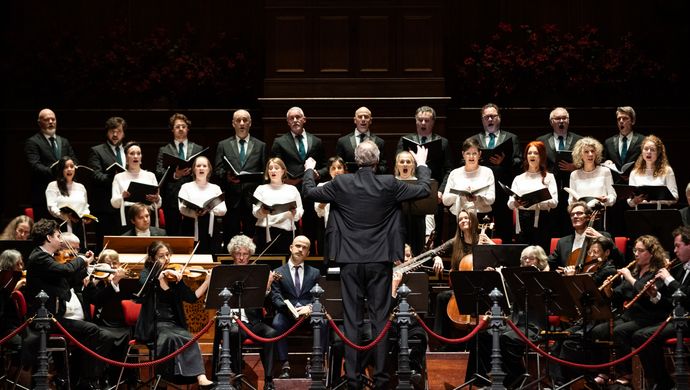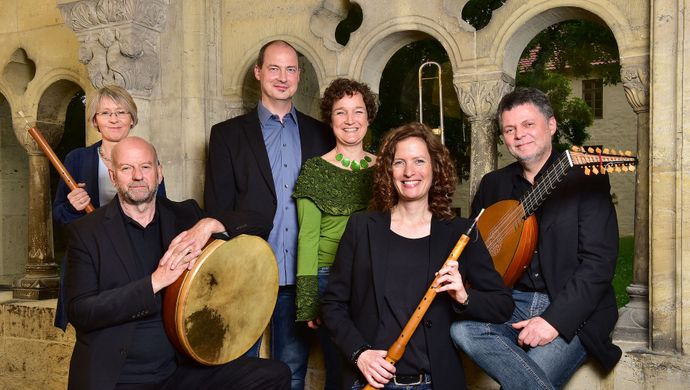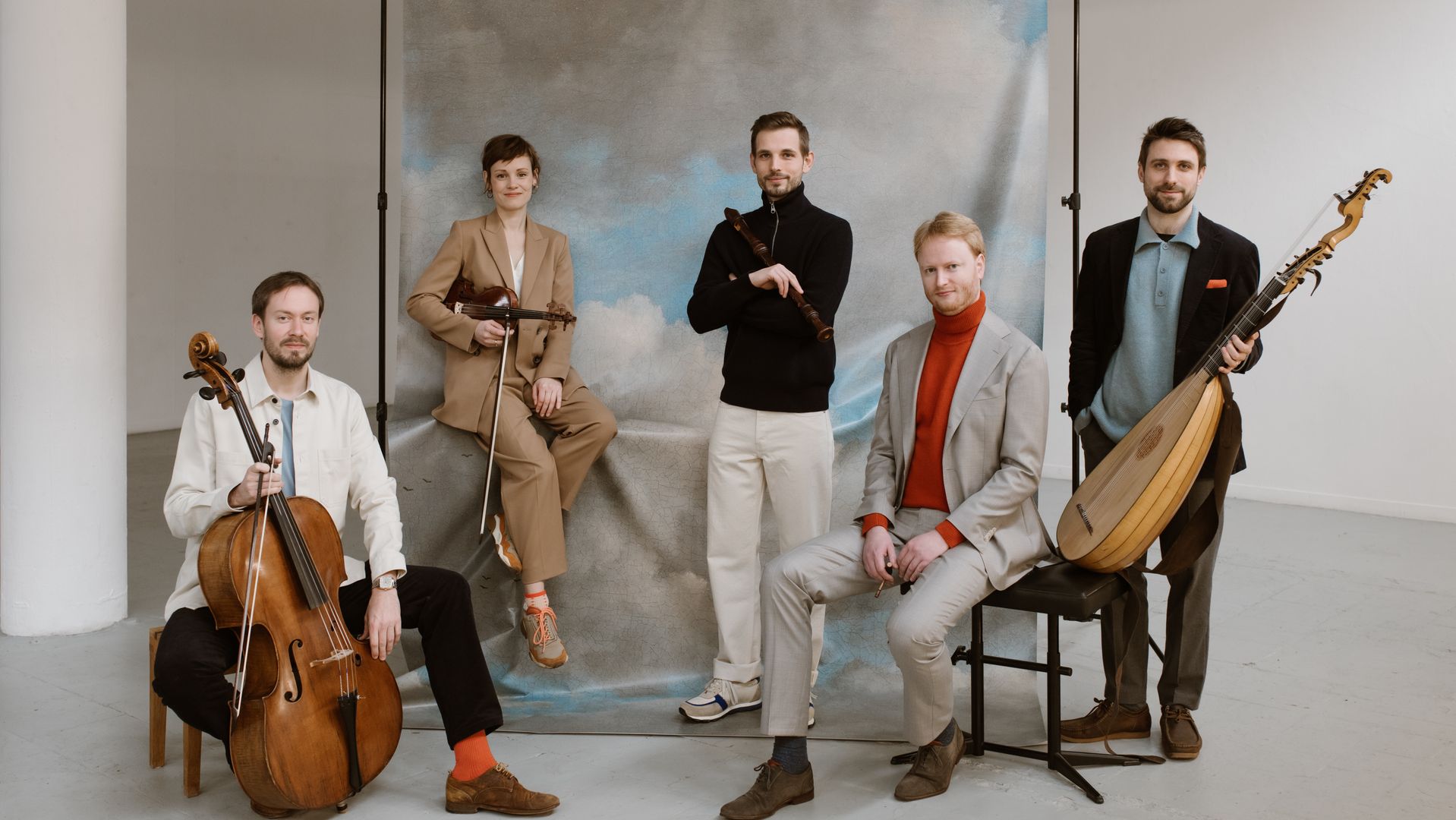
Programme notes:
Italophilia - Discovering the Italian taste in London / The Counterpoints
Sa 2 Nov ’24 / 20:15 / Nieuwe Kerk
Programme notes
In 1624, the English poet John Donne published his Devotions upon Emergent Occasions. The seventeenth devotion of this work contains the well-known line No man is an island, entire of itself. Isolation, Donne explains, is no human condition. We are always connected to other people in myriad ways. Nowadays, with social media and air travel, contact between the furthest regions of the earth has become almost worryingly inescapable. In the seventeenth and eighteenth century, the networks of many people were much more localized by comparison. But certain people, such as poets and musicians, did interact with other cultures constantly.
This CD by The Counterpoints, entitled Italophilia: Discovering the Italian style in Handel’s London, celebrates such cultural conversation. In particular, it investigates the Italian musical influences on English baroque music in the seventeenth and eighteenth century. Already in 1683, Henry Purcell (1659-1695) had written in the foreword of his Sonatas of three Parts that he had ‘faithfully endeavour’d a just imitation of the most fam’d Italian Masters’. In later years, the impact of these Italian Masters would only increase, reaching its apogee in the work of George Frideric Handel (1685-1759). This CD contextualizes Handel’s work with composers he influenced and was influenced by, both in England and Italy.
Contrasting figures
Italophilia opens with a ground for solo harpsichord by that other great figure of the English baroque, Henry Purcell. In many ways, Purcell was the musical antithesis of Handel. Purcell was born in England, and, although some foreign elements can be found in his music, he is often hailed as one of the most quintessentially English composers ever. Purcell’s musical forms are relatively conservative, but his harmonies and use of counterpoint are sometimes progressive and adventurous. For example, his Sonata no. 10 in D major, included on this CD, features daring suspensions in the third movement on the one hand. On the other hand, the abrupt meter change in the last movement is reminiscent of Italian music from the early seventeenth century.
All of this stands in stark contrast to Handel. Handel, who adopted England as his native land only later in life. Handel, whose music incorporated elements from every country he had lived in. Handel, who experimented with form much more than with harmony. Handel, whose views of most English composers were, according to his biographer Charles Burney (1726-1814), ‘not complimentary’. Despite these contradictions, Handel was influenced by Purcell, especially in his word-setting of vocal music. This shows how, perhaps more than anything, Handel was a clever and flexible composer, who took inspiration (and musical material for that matter) from wherever he could find it.
Italian
Aside from the German polyphonic tradition, Handel’s music is most indebted to the Italian baroque. This influence stemmed from having worked in Italy for several years in the early 1700s, before moving to London in 1710. Several born Italians both preceded and followed him to the English capital. Examples of such composers and performers include Francesco Geminiani (1687-1762), and Nicola Matteis (1650- c.1714), both of whom are featured on this CD. Their presence both resulted from and contributed further to the popularity of Italy, Italian culture and music in London and the British Isles.
One form in particular would prove to be a great influence on Handel and his contemporaries: the cantata da camera or chamber cantata. This form developed in the early 1700s as a kind of amalgamate of the, at that time, frowned-upon secular operas, the sacred cantatas, and the vocal chamber music of the time. Although sometimes seen as mini opera’s, their more intimate setting and often more contemplative nature present different challenges to musicians and singers alike. This CD includes a particularly striking example of the form: Augellin, vago e canoro (1699) by Alessandro Scarlatti (1660-1725). This cantata, one of the around 800(!) he wrote, uses the recurring theme of the captive bird, symbolizing unrequited love.
Handel and others
Handel produced many chamber cantates of his own. Italophilia contains one of them: Pensieri notturni di Filli. It consists of four movements, alternating recitatives and arias. It deals with the general theme of the deceptive dream and the disillusionment of awakening by looking into the thoughts of the sleeping Phyllis. She dreams of embracing her lover, but upon waking in the final aria feels the pain of deception: her lover is unattainable. The seemingly uplifting but ultimately melancholic text forms a perfect whole with the punctuated rhythms, which may seem active but turns out to be lulling instead.
With a star of Handel’s magnitude shining in the musical firmament, there was little room for other composers in Londen. Still, some did carve out niches for themselves. One of these composers was Maurice Greene (1696-1755). Although Michael Talbot, a renowned scholar of the Italian Baroque, calls his works ‘of a quality to match their Handelian counterparts’, he is nowadays relatively little-known. This is especially true for his 37 Italian-language compositions. Perhaps because of this, the aria included on this CD, Farfalletta festosetta, seems to be a world premiere recording.
Emphasizing the ensemble
The Counterpoints have released two earlier CDs: La Querelleuse (2020) and Thomascantors in Dialogue (2022). On these, they focused on German composers, in particular Georg Philipp Telemann (1681-1767). On Italophilia, their third CD, the geographical focus shifts to Italy and England. As a consequent, there is a musical relocation, towards a different kind of expression, more contrast between lively and cantabile movements, and solo and tutti moments. Taking Handel as the key figure for this CD then is very fitting, as he had connections to all three countries.
Another key aspect of the current CD is its versatility. Italophilia features compositions by no less than nine composers, and only Handel and Purcell contribute two. Moreover, few of the pieces feature the same combinations of instruments. ‘We wanted this to be a real ensemble CD, on which every instrument gets its moment to shine’, says recorder player Thomas Triesschijn of The Counterpoints. ‘Moreover, this approach enabled us to invite friends of ours to play along’. Of these friends, soprano Kristen Witmer’s presence is most pronounced. Violinist Matthea de Muynck explains: ‘On our CD, the vocal music and its narrative elements runs like a thread through our entire program. This reflects Handel’s oeuvre, in which vocal music also has a central place.’ - Marten van der Meulen
In 1624, the English poet John Donne published his Devotions upon Emergent Occasions. The seventeenth devotion of this work contains the well-known line No man is an island, entire of itself. Isolation, Donne explains, is no human condition. We are always connected to other people in myriad ways. Nowadays, with social media and air travel, contact between the furthest regions of the earth has become almost worryingly inescapable. In the seventeenth and eighteenth century, the networks of many people were much more localized by comparison. But certain people, such as poets and musicians, did interact with other cultures constantly.
This performance by The Counterpoints, entitled Italophilia: Discovering the Italian style in Handel’s London, celebrates such cultural conversation. In particular, it investigates the Italian musical influences on English baroque music in the seventeenth and eighteenth century. Already in 1683, Henry Purcell (1659-1695) had written in the foreword of his Sonatas of three Parts that he had ‘faithfully endeavour’d a just imitation of the most fam’d Italian Masters’. In later years, the impact of these Italian Masters would only increase, reaching its apogee in the work of George Frideric Handel (1685-1759). This programme contextualizes Handel’s work with composers he influenced and was influenced by, both in England and Italy.
Contrasting figures
Italophilia opens with a ground for solo harpsichord by that other great figure of the English baroque, Henry Purcell. In many ways, Purcell was the musical antithesis of Handel. Purcell was born in England, and, although some foreign elements can be found in his music, he is often hailed as one of the most quintessentially English composers ever. Purcell’s musical forms are relatively conservative, but his harmonies and use of counterpoint are sometimes progressive and adventurous. For example, his Sonata no. 10 in D major, included in this programme, features daring suspensions in the third movement on the one hand. On the other hand, the abrupt meter change in the last movement is reminiscent of Italian music from the early seventeenth century.
All of this stands in stark contrast to Handel. Handel, who adopted England as his native land only later in life. Handel, whose music incorporated elements from every country he had lived in. Handel, who experimented with form much more than with harmony. Handel, whose views of most English composers were, according to his biographer Charles Burney (1726-1814), ‘not complimentary’. Despite these contradictions, Handel was influenced by Purcell, especially in his word-setting of vocal music. This shows how, perhaps more than anything, Handel was a clever and flexible composer, who took inspiration (and musical material for that matter) from wherever he could find it.
Italian
Aside from the German polyphonic tradition, Handel’s music is most indebted to the Italian baroque. This influence stemmed from having worked in Italy for several years in the early 1700s, before moving to London in 1710. Several born Italians both preceded and followed him to the English capital. Examples of such composers and performers include Francesco Geminiani (1687-1762), and Nicola Matteis (1650- c.1714), both of whom are featured in this programme. Their presence both resulted from and contributed further to the popularity of Italy, Italian culture and music in London and the British Isles.
One form in particular would prove to be a great influence on Handel and his contemporaries: the cantata da camera or chamber cantata. This form developed in the early 1700s as a kind of amalgamate of the, at that time, frowned-upon secular operas, the sacred cantatas, and the vocal chamber music of the time. Although sometimes seen as mini opera’s, their more intimate setting and often more contemplative nature present different challenges to musicians and singers alike. This programme includes a particularly striking example of the form: Augellin, vago e canoro (1699) by Alessandro Scarlatti (1660-1725). This cantata, one of the around 800(!) he wrote, uses the recurring theme of the captive bird, symbolizing unrequited love.
Handel and others
Handel produced many chamber cantates of his own. Italophilia contains one of them: Pensieri notturni di Filli. It consists of four movements, alternating recitatives and arias. It deals with the general theme of the deceptive dream and the disillusionment of awakening by looking into the thoughts of the sleeping Phyllis. She dreams of embracing her lover, but upon waking in the final aria feels the pain of deception: her lover is unattainable. The seemingly uplifting but ultimately melancholic text forms a perfect whole with the punctuated rhythms, which may seem active but turns out to be lulling instead.
With a star of Handel’s magnitude shining in the musical firmament, there was little room for other composers in Londen. Still, some did carve out niches for themselves. One of these composers was Maurice Greene (1696-1755). Although Michael Talbot, a renowned scholar of the Italian Baroque, calls his works ‘of a quality to match their Handelian counterparts’, he is nowadays relatively little-known. This is especially true for his 37 Italian-language compositions.
After Marten van der Meulen
Programma
Henry Purcell (1659-1695)
Ground voor klavecimbel solo in d mineur
Sonata nr. 10 in D majeur uit ‘10 Sonatas in Four Parts’ (Londen, 1697)
Adagio
Canzona
Grave
Largo - Allegro
Alessandro Scarlatti (1660-1725)
Augellin, vago e canoro (Napels, 1699)
Aria: Augellin vago e canoro
Recitatief: Pur senza mai posare
Aria: Io t’intendo, gentil prigioniero
Recitatief: Ma del tuo duol fatta pietosa Irene
Aria: Quanto invidio i tuoi bei voli
John Eccles (1668-1735)
Ground Air uit The Mad Lover (London, ca. 1701) in A mineur
George Frideric Handel (1685 - 1759)
Pensieri notturni di Filli (Nel dolce dell’ oblio), HWV 134 in F majeur (Rome, ca. 1707)
Recitatief: Nel dolce dell’oblio
Aria: Giacché il sonno a lei dipinge
Recitatief: Così fida ella vive
Aria: Ha l’inganno il suo diletto
Tollets ground in G majeur uit The Division Flute (London, 1706)
George Frideric Handel
Triosonate Op. 2 Nr. 1b in b mineur, HWV 386b (London, 1733)
Andante
Allegro
Andante
Allegro
-Pauze-
Thomas Baltzar (c. 1630 – 1663)
John come kiss me now (on a ground) in G majeur
Francesco Geminiani (1687-1762)
Cellosonate op. 5 nr. 2 in d mineur, (Parijs, 1746)
Andante
Presto
Adagio
Allegro
Robert Carr (fl. 1684-87)
Division upon an Italian Ground uit The Division Flute (London, 1706)
Maurice Greene (1696-1755)
Aria: Farfalletta festosetta
Antonio Vivaldi (1678-1741)
Concerto da Camera in F majeur, RV 100
All’o
Largo
All’o
Uitvoerende
Musici
Kristen Witmer sopraan
The Counterpoints
Thomas Triesschijn blokfluit
Noyuri Hazama viool
Diederik van Dijk cello
Aljosja Mietus klavecimbel
Ensemble The Counterpoints is een oudemuziekcollectief rondom blokfluitist Thomas Triesschijn en klavecinist Aljosja Mietus dat sinds 2015 in verschillende bezettingen samenspeelt. The Counterpoints legt zich toe op de uitvoering van muziek uit de 17e en 18e eeuw op kopieën van historische instrumenten. Hun naam is afkomstig van de compositietechniek contrapunt en impliceert verschillende stemmen die een gelijkwaardige rol binnen een muziekstuk spelen. Iedere stem heeft een uniek karakter, maar het geheel is meer dan de som der delen. Voor The Counterpoints werkt musiceren in een kamermuzikale context precies hetzelfde.
Amerikaans-Koreaanse sopraan Kristen Witmer groeide op in Tokyo. Inmiddels woont ze in Nederland en treedt ze met een breed repertoire wereldwijd op als solist. Ze werkte samen met gerenommeerde dirigenten waaronder Philippe Herreweghe, Masaaki Suzuki, Masato Suzuki, Jos van Veldhoven, Rudolf Lutz en Joshua Rifkin.
‘The Counterpoints [...] have become a mainstay on the concert and festival scene, garnering consistently high praise’ James V. Maiello, Fanfare Magazine (sept/oct 2022)
